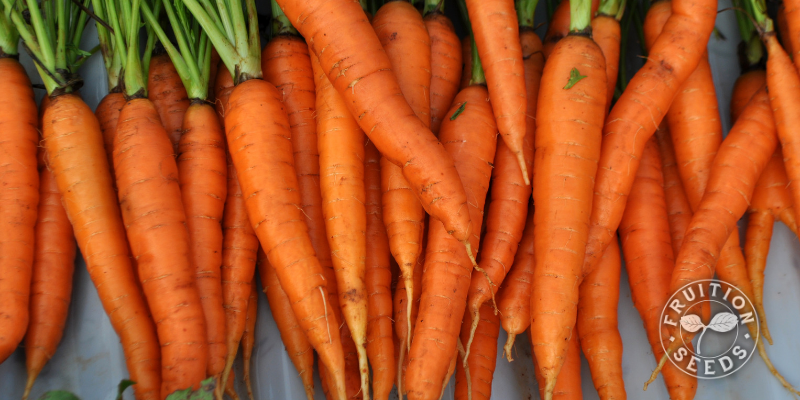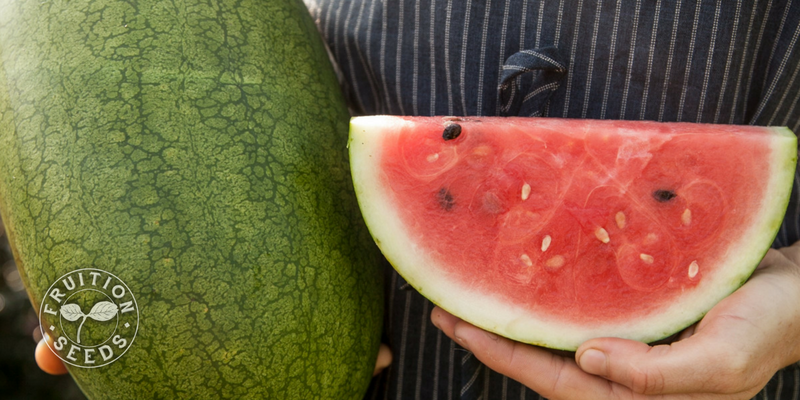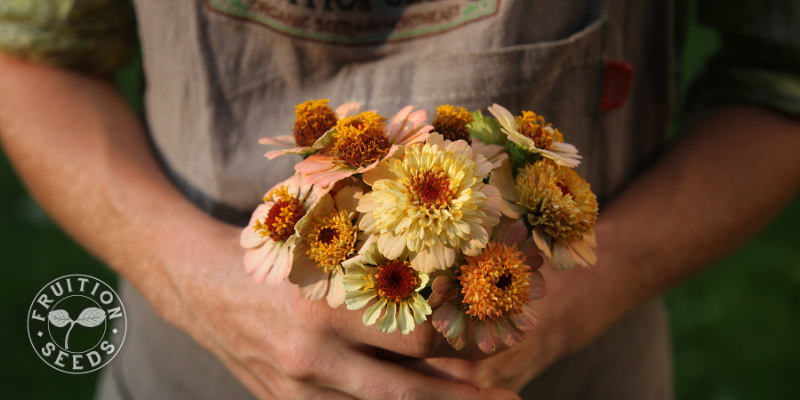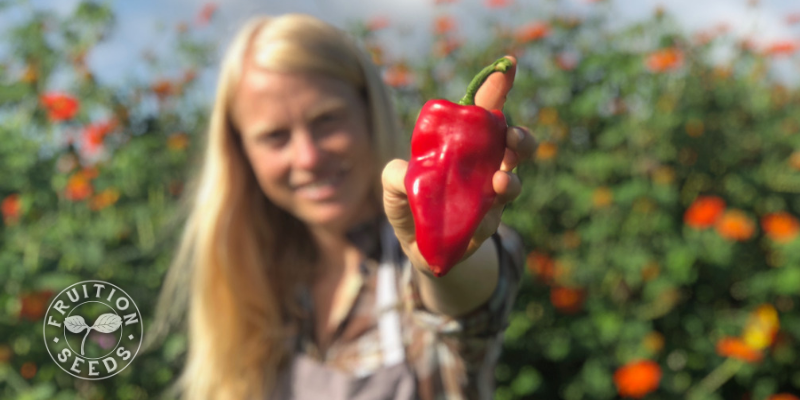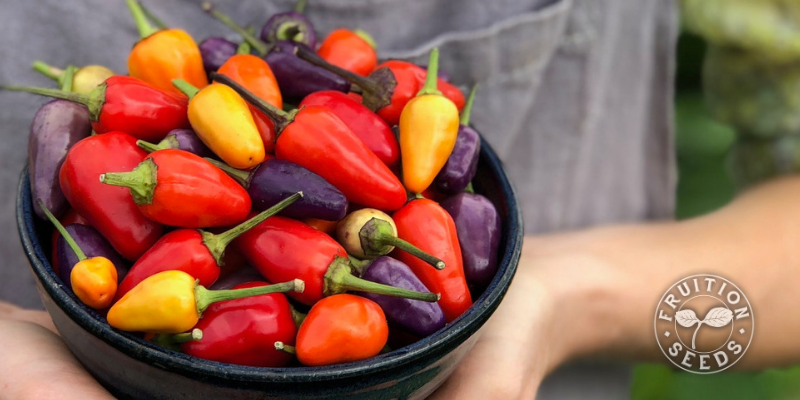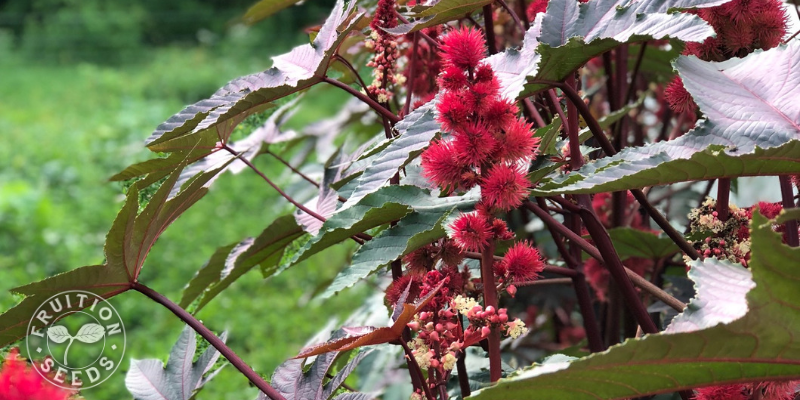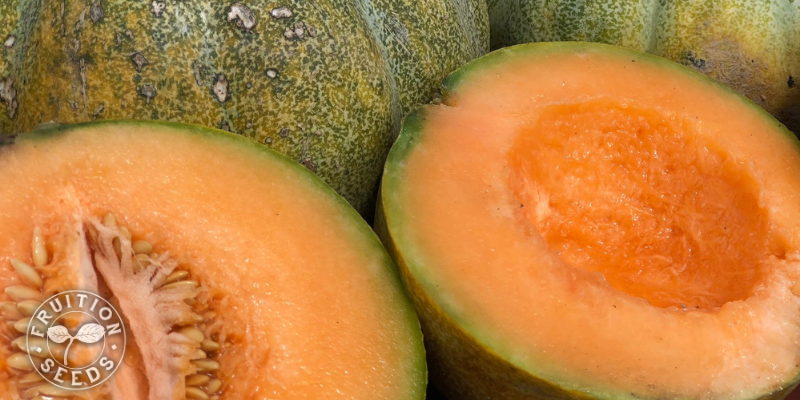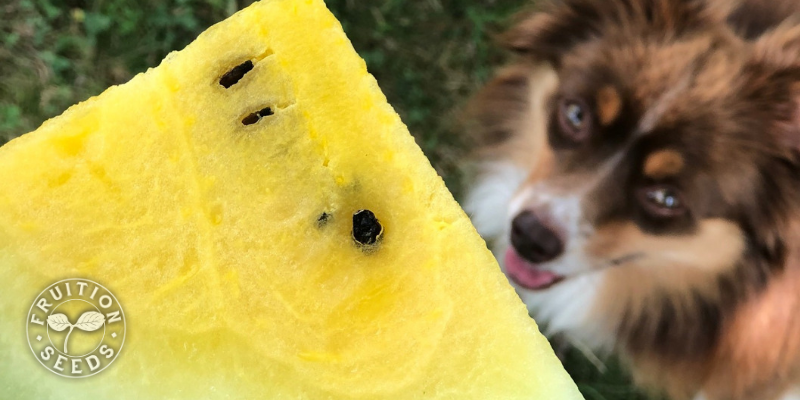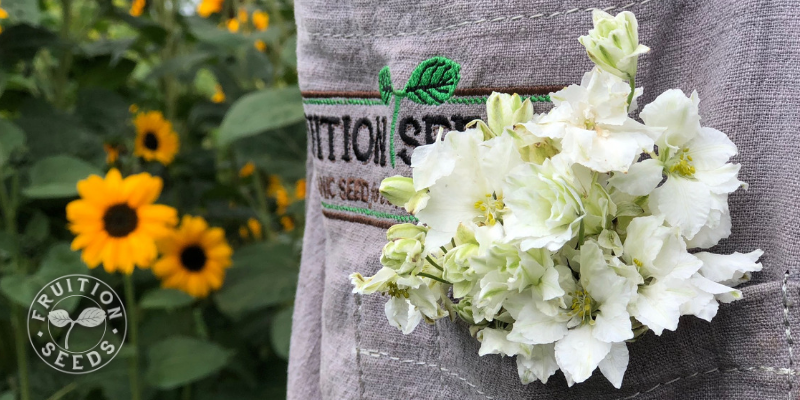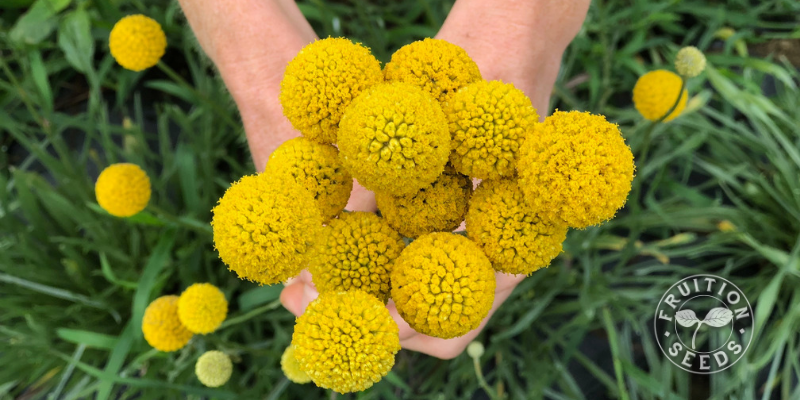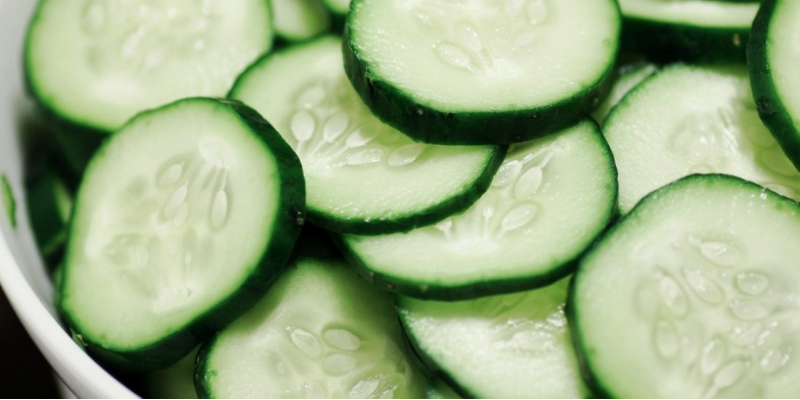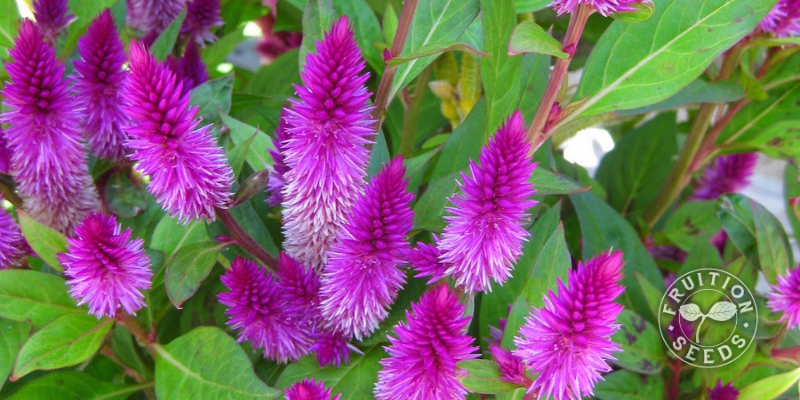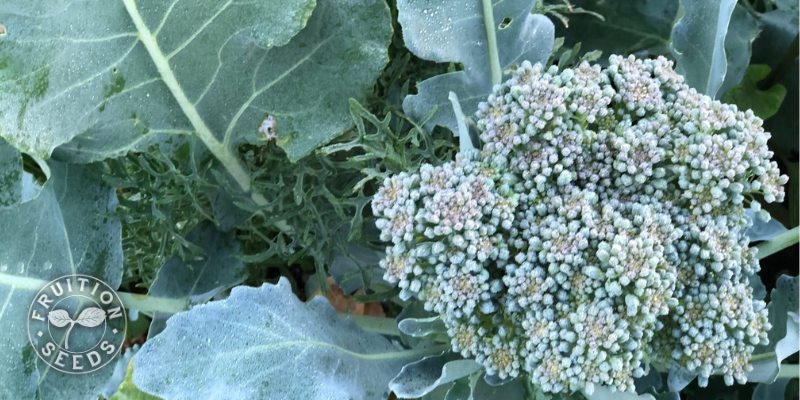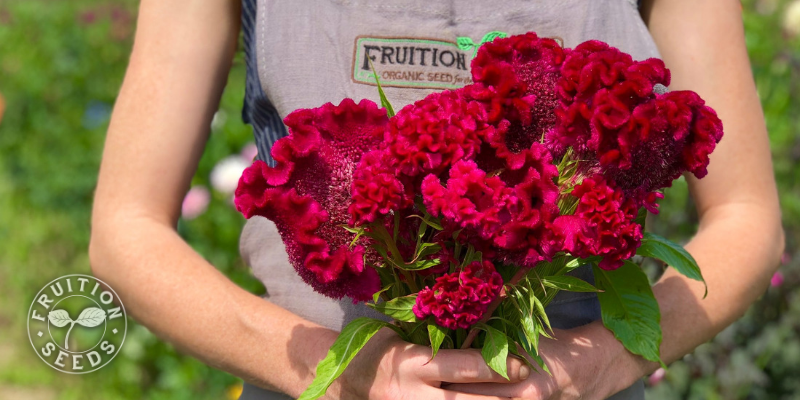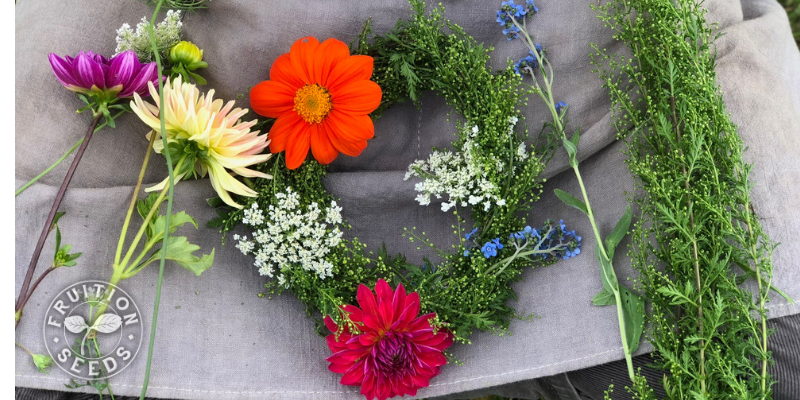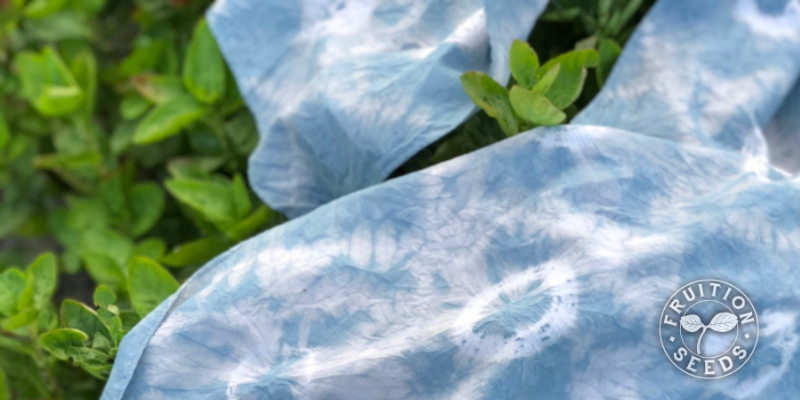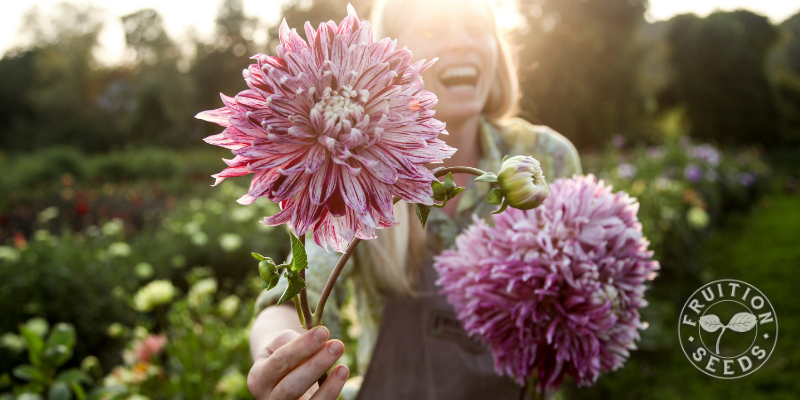Each year we trial new varieties and develop new ones, harvesting their seeds and tucking in packets to share with you!
With each season we learn more about our seeds, ourselves, our soil, our community and our climate. Most seed companies are simply repackaging seed they’ve bought wholesale on the commodity market, which doesn’t eliminate all the variables by any means, but it does greatly reduce their risk of not having seed in their packets.
The seeds in our packets is largely harvested on one of Fruition’s four farms; we also collaborate with over a dozen talented organic seed growers to bring you the highest quality seed we can source.
And Friends, we don’t always reap what we sow. Though we grew a glorious bed of Lime Queen zinnias this summer, persistent rain brought powdery mildew early to her leaves and filled her seedheads with millions of spores instead of seeds. (Thank goodness our Zinderella Peach zinnias, below, were a different story!) So yes, in every year we’ve grown seed, we watched countless seeds vanish before our eyes.
Nevertheless, we’ve managed to grow enough seed to now celebrate the beginning of Fruition’s seventh year!
And nevertheless, we have exquisite seeds of extraordinary varieties, fresh for 2019, to share with you.
Here is the sneak peek, with several more to come, including ginger for you to grow your own and a handful of new dahlias we can’t imagine life without. Stay tuned, we can’t wait to share them with you
Dulcinea Carrot
A new variety bred by Fruition Seeds! Dulcinea is sweet and straight, well-adapted and now undaunted by the stones in our soil. She is more vigorous than most, producing earlier harvests throughout the season. Her fall roots store sweet in the cellar til spring, as well.
August Ambrosia Watermelon
We want to eat fresh watermelon from the garden every day in August, which has been a lot to ask since most varieties are bred for California rather than the Northeast. Which is why we collaborated with Michael Mazourek of Cornell to develop a new variety, August Ambrosia, beautifully adapted for our short seasons. August Ambrosia’s perfectly petite 4- to 6-pound oblong fruits ripen abundantly throughout August even in short, cool summers. Truly a watermelon worth your time & precious garden space.
Zinderella Peach Zinnia
A Seussian zinnia, this Zinderella! I confess I fell in love with this flower, but only come August. Her first flush was interesting but solidly uninspiring. We cut them back (as so many flowers love) and sure enough, her blossoms ‘til frost were an absolutely stunning array of single, double and fully double blossoms in a dreamy peach palette, perfect for cutting.
Mountaineer Sweet Pepper
If you garden in short seasons, like us in Zone 5 here the Finger Lakes, ripening more than a handful of red peppers in a season is a trick. Will Bonsall first shared Mountaineer with us in June – two months after it’s optimal to start your peppers – but we started some anyhow, just to see how early they truly are. That season we saved seeds of many red peppers, blown away that any matured at all. Start them in April, you’ll likely be filling your freezer with abundance.
Chinese 5-Color Hot Pepper
Our dear friend Dan in Montreal loves growing these peppers! We now love growing them in the Finger Lakes, as well. And Friends, they’re gorgeous. Each plant has variegated green and yellow foliage tinged with violet with dozens of brilliantly-hued and righteously spicy peppers. With ten times the heat of a jalapeno on the Scoville Scale, Chinese Five-Color is perhaps boring for the serious heat freaks but plenty to work with for the rest of us
Castor Bean
Not subtle or subdued, castor beans are unapologetically gorgeous tropical behemoths, quickly growing eight feet by early August with ruby leaves two feet wide, still shooting for the sky. Though they are very poisonous both internally and externally to mammals, hummingbirds sip their nectar all day long and sparrows often take up residence in their lush foliage. Castor beans are easy to grow and thrive in any soil, so long as they have full sun.
Petit Gris de Renne Cantaloupe
“This melon gives me the chills,” says Amy Goldman. “You will blink your eyes with disbelief when you sample its sweetness, which is more like brown sugar than white. She will melt on your tongue, and your mouth will water for more.” Petit Gris de Renne roughly translates to ‘small gray of Renne,’ the village in France where this melon has been savored for centuries. She is surprisingly easy to grow, even in short seasons, producing 3 to 4 exquisite fruit per plant.
Honey Island Watermelon
We were instantly smitten with Honey Island’s brilliant yellow flesh, full flavor and sticky sweetness, a gift from Heron Breen of Fedco in Maine. Its round, icebox-style 6- to 8-pound fruits, perfect for a picnic. On a desert island. Any day.
White Larkspur
Exquisite yet simple, delicate yet tenacious. Each ivory double-blossom has petals edged with glorious spring green. Swoon! White Larkspur’s spires of blossoms stack on strong stems perfect for cutting. Hummingbirds and butterflies flock to our larkspur each summer.
Craspedia
With unlikely yet unending charm, Craspedia is celebrated by both Dr. Seuss and Martha Stewart. Craspedia goes by many marvelous names, from drumstick flower to billy balls to sun ball. She’s easy to grow, producing a bustling skyline of inch-wide golden blossoms on long 20+ inch silver stems perfect for cutting. Her understory of silver foliage is an ornamental tuft unto itself. Craspedia makes very few demands, thriving in poor soil and even in drought.
NY Slicing 264 Cucumber
As Downy mildew becomes more and more prevalent, this cucumber will become more and more common. With impressive resistance to Downy mildew, NY 264 has become our go-to for our July cucumber successions, deliciously abundant and un-phased in the height of late summer disease, powering on ’til frost. A classic American slicer with classic flavor, the remarkable thing is this: cucumbers are still abundant in your garden, weeks after all other varieties have turned brown and died. Thank you Michael Mazourek and Cornell University for regionally adapting another genius cucumber for growers in the Northeast!
Ruby Parfait Celosia
Ruby Parfait is a whimsical plant and such a joy to grow! Dozens of iridescent rose spires rise on strong 16+ inch stems ideal for arrangements both fresh and dry. The more you harvest, the more you’ll continue to harvest. Initial blooms are often over three inches tall, gradually getting smaller with each successive harvest. From boutonnieres and garlic braids to autumn wreaths and winter bouquets, you’ll be amazed how many ways celosia will brighten your days.
Calabrese Broccoli
Let’s be honest: Harvesting a head of broccoli larger than a grapefruit is quite a feat here in the Northeast. The quick heat of summer is challenging for many varieties to head up consistently, especially among open-pollinated heirloom varieties. We’ve found Calabrese to buck the trends, producing a generous head of tender broccoli followed by an abundance of blue-green side-shoots to enjoy well into autumn. Yet another Italian heirloom variety that thrives in the Finger Lakes!
Red Flame Celosia
This cockscomb-style celosia is like vivid red velvet, with striking burgundy leaves that wowed us all summer. Its long, strong 20+ inch stems are ideal for both fresh and dry arrangements. The more you harvest, the more you’ll continue to harvest. From boutonnieres and garlic braids to autumn wreaths and winter bouquets, we’re grateful to have grown more Red Flame than we needed for seed this season! You’ll find it in wreaths and bouquets around our home this winter
Sweet Annie
Sweet Annie is our go-to for flower crowns and bouquet filler! Her deep green, fern-like foliage quickly grows 4 to 6 feet tall, even in poor soil and partial sun. She is sweetly fragrant, like so many of her cousins in the sage family, remaining so for years in dry arrangements and wreaths.
Round-Leaf Indigo
Our dear friend Jeanne Cease loves to dye and this is the most concentrated, compelling indigo she’s found. Indigo is easy to grow, leaping out of the ground to quickly outcompete weeds. You can easily harvest two successions of leaves each season, even three if you’re committed. It’s rich indigo hues are a dream to work with.
Thank You!
And cheers for an abundant 2019!
We give thanks for another great season of growing, of learning and of sharing it all with you, Friends
Sow Seeds & Sing Songs,

and the Many Beings of Fruition
ps
Stay tuned for the ginger and dahlia tubers we’ll soon be sharing! Here is one of my favorites, Avignon:

